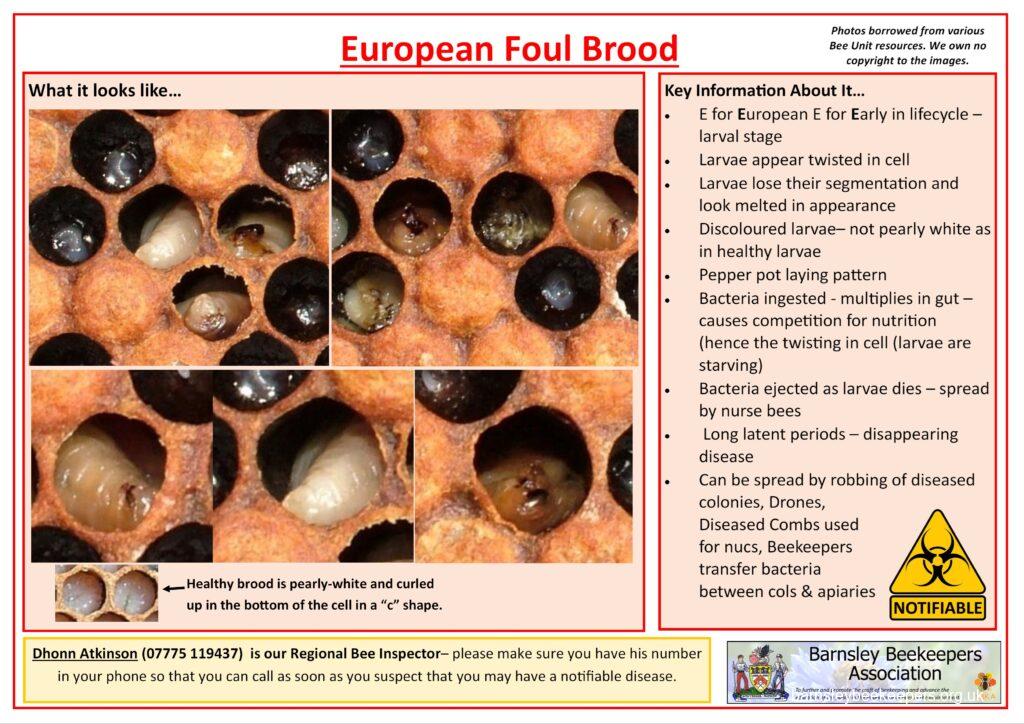Understanding the disease, its spread, and how to protect your bees
Based on the YouTube video By Colin Pavey
When it comes to brood diseases, European Foulbrood (EFB) is one that no beekeeper can afford to ignore. A serious and notifiable disease, EFB can quietly take hold in your hives before you ever see signs of trouble. Colin Pavey, an experienced inspector from the National Bee Unit (NBU), delivered a detailed and practical talk on EFB, and this blog distils his wisdom into a reference you can return to season after season.
What is European Foulbrood?
EFB is caused by the bacterium Melissococcus plutonius (or, as Colin calls it for ease, “Mp”). This bacterium infects honeybee larvae, depriving them of nutrition. Larvae eventually die of starvation, twist in their cells, and decay — spreading the bacteria throughout the colony.
Crucially, EFB strikes before the brood is sealed — remember:
E is for European, E is for Early.
The disease is particularly dangerous because:
- It’s highly contagious.
- It progresses slowly, so colonies may look healthy while harbouring infection.
- Bees’ natural behaviours, like cleaning and feeding, spread the bacterium easily.
EFB is a notifiable disease. If you suspect EFB, you are legally required to report it to the National Bee Unit.
How EFB Develops in the Hive
Colin explains the disease in two main phases:
- The Infection Phase (Invisible Threat)
- Mp invades the colony, often via contaminated brood food.
- Larvae ingest the bacteria, which then multiply quietly in their mid-gut.
- No visible signs at this stage — colonies seem healthy.
- The Disease Phase (Visible Symptoms)
- As Mp multiplies, larvae are drained of nutrition.
- They twist, shrink, lose their healthy pearly-white colour, and die.
- Dead larvae decompose, spreading the bacteria further via house bees and cleaning activities.
Mp is a remarkably persistent bacterium. Even without visible signs, it can linger on old combs, hive parts, and equipment for years, waiting for the right conditions to flare up.
Spotting EFB: Symptoms and What to Look For
Early detection is critical. Signs include:
- Discoloured, twisted larvae: Larvae lose their segmentation and become yellowed or brown.
- Melted appearance: Infected larvae slump to one side of the cell, looking “melted.”
- Pepper-pot or spotty brood pattern: As diseased larvae are removed, a patchy laying pattern emerges.
- Ragged cell openings: Bees trying to remove dead pupae leave torn holes.
- Dried scale: Decomposed larvae dry into a brown, toffee-like residue.
- Odour: In advanced cases, bacterial breakdown can cause a sour smell, though this is not always present.

Tip: Use your phone to photograph suspicious brood and contact your NBU inspector immediately. Early action prevents spread!
The Complexity of EFB Spread
Colin makes clear that EFB spreads incredibly easily, and that we, as beekeepers, play a pivotal role in transmission. Routes include:
- Drift of disoriented bees during inspections.
- Contaminated tools, gloves, and clothing.
- Shared equipment between colonies or apiaries.
- Swarms from infected colonies.
- Bee robbing and feeding on contaminated honey stores.
- Beekeepers handling multiple apiaries without strict hygiene.
High colony density increases risk. Local hotspots can become persistent problems, even with good management.
Practical Control Measures
When EFB is confirmed, your NBU inspector will supervise control methods. Options include:
- Destruction: If infection is severe, colonies and combs are destroyed by burning, and equipment is sterilised.
- Shook Swarm Method:
For low-level infections, this is highly effective:- Shake bees into a clean hive with new foundation.
- Burn old brood frames.
- Delay feeding to starve out Mp in the interim.
- Sterilise all equipment and isolate the apiary.
Important: Even if only one colony shows signs, it’s best to treat the entire apiary. Silent infections are common in neighbouring hives.
Standstill Orders: When EFB is confirmed, you will receive a legally binding standstill notice. No equipment, bees, or materials should leave the apiary until cleared by the NBU.
Long-Term Vigilance: Biosecurity and Hygiene
One of the most important lessons from Colin’s talk is that good hygiene is your best defence.
- Clean hive tools, gloves, and suits regularly.
- Disinfect equipment between apiaries.
- Avoid swapping frames and boxes between colonies.
- Inspect brood frames under good light three times a year.
- Remove and destroy old combs and dead colonies promptly.
- Avoid risky practices like leaving honey supers out for robbing.
Colin also highlights lessons learned from Covid-19: the importance of biosecurity. Think about every surface you touch — steering wheels, smokers, hive tools — and keep it clean.
The Importance of BBase
Finally, make full use of the BeeBase website:
- Register your apiaries.
- Receive alerts about local outbreaks.
- Access disease incidence reports.
- Download comprehensive guidance on EFB, American Foulbrood, and other common brood diseases.
BeeBase is a valuable resource that helps inspectors target inspections and control the spread of disease.
In Conclusion
European Foulbrood is a persistent and sneaky adversary. It may be with you long before you ever spot the signs. But with vigilance, hygiene, and prompt action, you can protect your bees and help prevent the spread of this damaging disease.
As Colin signs off:
“Mp is a very sneaky little bug — very, very unforgiving. If you give it half a chance, it will appear again.”
Keep up your inspections. Keep clean. And keep your colonies healthy!
Useful Resources
- BeeBase — for alerts, registration, and guidance
- National Bee Unit (NBU) — contact your local inspector at the first sign of trouble
- British Beekeepers Association (BBKA) — training and disease updates
